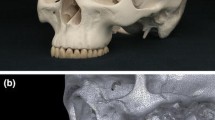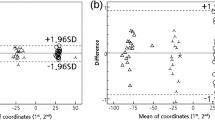Abstract
Objectives
The aim of this study was to investigate the accuracy and reliability of registration methods for replacing dental areas of three-dimensional (3D) computed tomography (CT) images with 3D light-scanned dental images using tooth cusp tips and the occlusal surface. The number of registration points was investigated for its impact on the tooth cusp tip-based method.
Methods
Computed tomography image data on ten skull models and light-scanned data from dental cast models of the skulls were registered with imaging registration software. The marker-free registration using tooth cusp tips involved five protocols identifying 3–14 points as registration references. The control registration protocol consisted of a surface-matching method that used the occlusal surface. Errors were measured between the reference data and the registered images at the mesial, distal, buccal, and lingual tooth surfaces.
Results
For image registration using dental cusp tips, the mean error ranged from 0.164 mm for seven points to 0.198 mm for 14 points. The error did not decrease with an increase in the number of registration points from three to 14. The use of dental cusp tips resulted in no significant error with respect to the number of registration points. Image registration using the occlusal surface yielded a mean error of 0.116 mm. Significant differences between the errors were observed in comparisons of the dental cusp tip and occlusal surface registrations.
Conclusions
When positioning scanned dental images onto CT images, surface-based image registration using the occlusal surface gives less error than reference point-based image registration with dental cusp tips. We found no significant difference in the error with an increase in the number of registration points from three to 14.


Similar content being viewed by others
References
Nkenke E, Zachow S, Benz M, Maier T, Veit K, Kramer M, et al. Fusion of computed tomography data and optical 3D images of the dentition for streak artefact correction in the simulation of orthognathic surgery. Dentomaxillofac Radiol. 2004;33:226–32.
Swennen GR, Barth EL, Eulzer C, Schutyser F. The use of a new 3D splint and double CT scan procedure to obtain an accurate anatomic virtual augmented model of the skull. Int J Oral Maxillofac Surg. 2007;36:146–52.
Kim BC, Lee CE, Park W, Kang SH, Zhengguo P, Yi CK, et al. Integration accuracy of digital dental models and 3-dimensional computerized tomography images by sequential point- and surface-based markerless registration. Oral Surg Oral Med Oral Pathol Oral Radiol Endod. 2010;110:370–8.
Uechi J, Okayama M, Shibata T, Muguruma T, Hayashi K, Endo K, et al. A novel method for the 3-dimensional simulation of orthognathic surgery by using a multimodal image-fusion technique. Am J Orthod Dentofacial Orthop. 2006;130:786–98.
Swennen GR, Mommaerts MY, Abeloos J, De Clercq C, Lamoral P, Neyt N, et al. The use of a wax bite wafer and a double computed tomography scan procedure to obtain a three-dimensional augmented virtual skull model. J Craniofac Surg. 2007;18:533–9.
Hoffmann J, Westendorff C, Leitner C, Bartz D, Reinert S. Validation of 3D-laser surface registration for image-guided cranio-maxillofacial surgery. J Craniomaxillofac Surg. 2005;33:13–8.
Luebbers HT, Messmer P, Obwegeser JA, Zwahlen RA, Kikinis R, Graetz KW, et al. Comparison of different registration methods for surgical navigation in cranio-maxillofacial surgery. J Craniomaxillofac Surg. 2008;36:109–16.
Eggers G, Muhling J. Template-based registration for image-guided skull base surgery. Otolaryngol Head Neck Surg. 2007;136:907–13.
Gateno J, Xia J, Teichgraeber JF, Rosen A. A new technique for the creation of a computerized composite skull model. J Oral Maxillofac Surg. 2003;61:222–7.
Park WS, Kim KD, Shin HK, Lee SH. Reduction of metal artifact in three-dimensional computed tomography (3D CT) with dental impression materials. Conf Proc IEEE Eng Med Biol Soc. 2007;2007:3496–9.
Lell MM, Meyer E, Kuefner MA, May MS, Raupach R, Uder M, et al. Normalized metal artifact reduction in head and neck computed tomography. Invest Radiol. 2012;47:415–21.
Eggers G, Muhling J, Marmulla R. Image-to-patient registration techniques in head surgery. Int J Oral Maxillofac Surg. 2006;35:1081–95.
West JB, Fitzpatrick JM, Toms SA, Maurer CR Jr, Maciunas RJ. Fiducial point placement and the accuracy of point-based, rigid body registration. Neurosurgery. 2001;48:810–6 (discussion 6–7).
Conflict of interest
None.
Author information
Authors and Affiliations
Corresponding author
Rights and permissions
About this article
Cite this article
Choi, YS., Kim, MK., Lee, JW. et al. Impact of the number of registration points for replacement of three-dimensional computed tomography images in dental areas using three-dimensional light-scanned images of dental models. Oral Radiol 30, 32–37 (2014). https://doi.org/10.1007/s11282-013-0136-2
Received:
Accepted:
Published:
Issue Date:
DOI: https://doi.org/10.1007/s11282-013-0136-2




